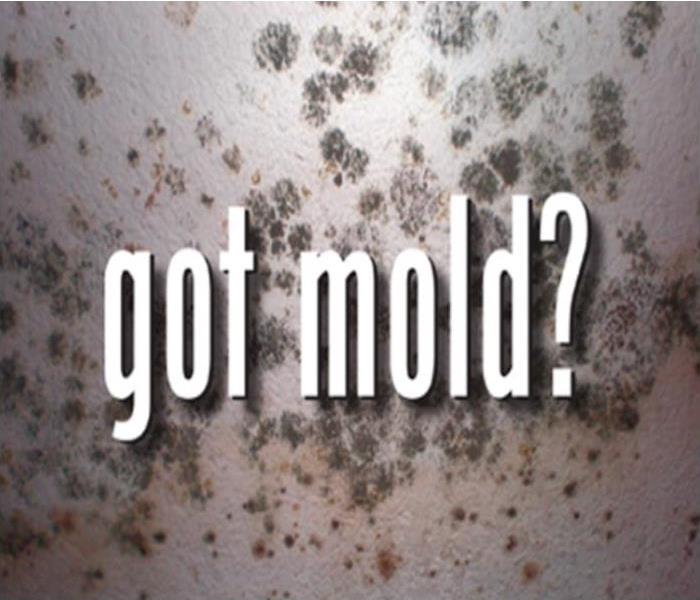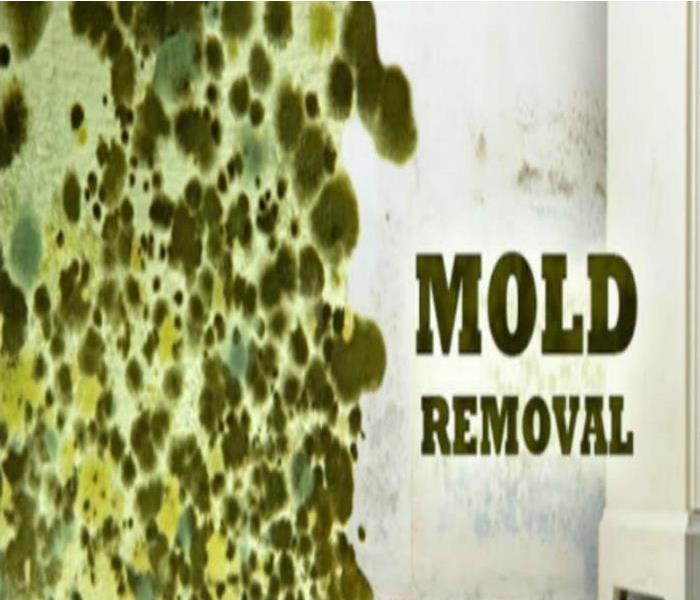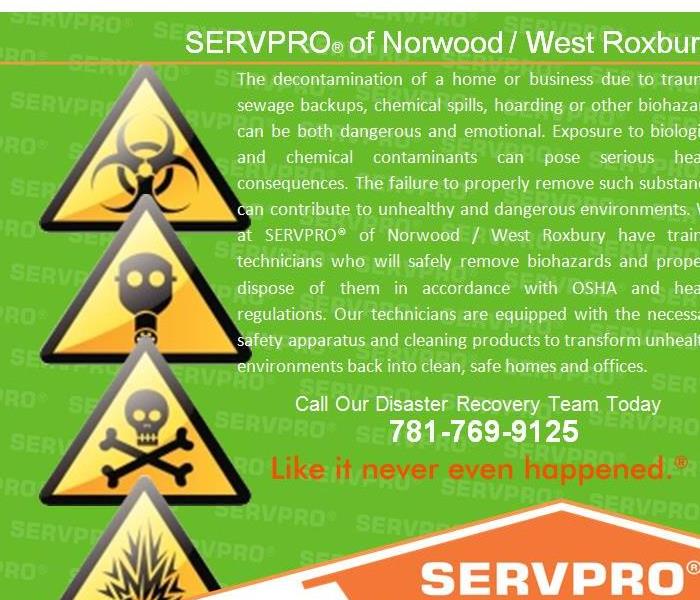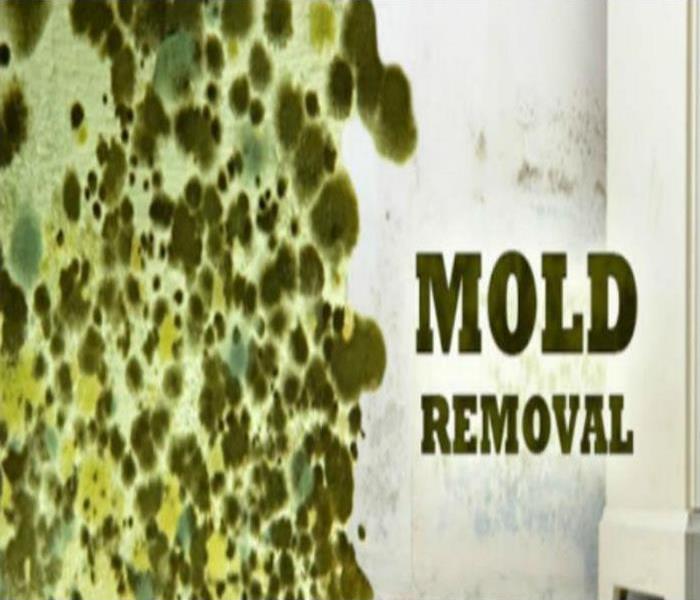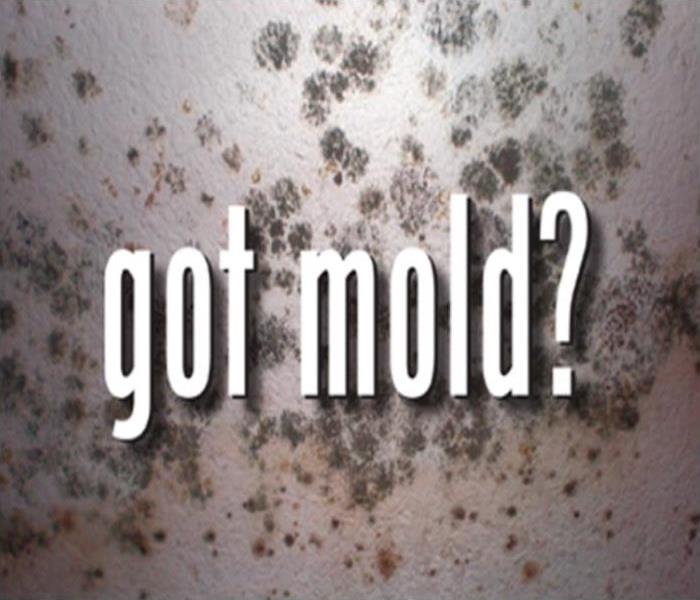Recent Mold Remediation Posts
Understanding and Preventing Mold Growth in Buildings During Summer Months
7/22/2024 (Permalink)
 Remember, early detection and prevention are key to keeping mold at bay.
Remember, early detection and prevention are key to keeping mold at bay.
As temperatures rise during the summer months, the risk of mold growth in buildings also increases. Mold thrives in warm, humid environments, making summer the perfect season for it to flourish. Understanding the causes of mold growth and how to prevent it is crucial for maintaining a healthy indoor environment.
The Causes of Mold Growth in Summer
- High Humidity Levels: Summer months often bring increased humidity, creating an ideal environment for mold. Mold spores require moisture to grow, and high humidity levels provide the necessary conditions.
- Poor Ventilation: Buildings with poor ventilation can trap moisture inside, leading to condensation on walls, ceilings, and floors. This trapped moisture provides a breeding ground for mold.
- Water Leaks and Dampness: Leaking pipes, roofs, and windows can introduce excess moisture into a building. Even minor leaks can create damp areas where mold can thrive.
- Condensation: Air conditioning systems can sometimes cause condensation, especially if they are not properly maintained. This condensation can accumulate and lead to mold growth.
Prevention Tips
- Control Humidity Levels: Use dehumidifiers to maintain indoor humidity levels below 60%. Air conditioning can also help reduce humidity, but ensure that the system is well-maintained to prevent condensation.
- Improve Ventilation: Ensure that your building has adequate ventilation. Use exhaust fans in bathrooms, kitchens, and laundry rooms to expel moisture. Opening windows can also help improve air circulation.
- Fix Leaks Promptly: Regularly inspect your building for leaks and address them immediately. Pay attention to areas around windows, roofs, and pipes. Fixing leaks promptly can prevent moisture buildup.
- Clean and Dry Damp Areas: If you notice any damp areas in your building, clean and dry them immediately. Use fans and dehumidifiers to speed up the drying process.
- Use Mold-Resistant Products: Consider using mold-resistant products, such as mold-resistant drywall and paint, in areas prone to moisture, like bathrooms and basements.
- Regular Maintenance: Perform regular maintenance checks on your HVAC system, plumbing, and roofing. Ensure that gutters and downspouts are clear of debris to prevent water from seeping into the building.
Preventing mold growth during the summer months requires proactive measures to control humidity, improve ventilation, and address any sources of moisture. By following these tips, you can create a healthier indoor environment and protect your building from the damaging effects of mold. Remember, early detection and prevention are key to keeping mold at bay.
Choose the #1 Experts in Cleanup and Restoration for Residential and Commercial Fire, Mold, Water, and Storm Damage. Contact us today! We can assist with your damage and restoration needs in Dedham, MA.
Understanding Mold: FAQs and Answers
7/11/2024 (Permalink)
 By understanding mold and how to prevent and address it, you can protect your home.
By understanding mold and how to prevent and address it, you can protect your home.
Mold is a common issue that many homeowners and property managers face. To help you better understand mold and how to deal with it, we've compiled a list of frequently asked questions about mold in East Dedham, MA:
What is Mold?
Mold is a type of fungus that thrives in moist environments. It reproduces by creating spores, which can spread through the air and settle on surfaces, where they can grow and multiply.
Where Does Mold Typically Grow?
Mold can grow on virtually any surface where moisture is present. Common areas for mold growth include bathrooms, kitchens, basements, and areas with water damage.
How Can I Prevent Mold Growth in My Home?
To prevent mold growth, it’s essential to control moisture levels in your home. This can be achieved by fixing leaks, using exhaust fans in bathrooms and kitchens, and using a dehumidifier in damp areas.
How Do I Know If I Have a Mold Problem?
Signs of a mold problem include visible mold growth, a musty odor, and water stains on walls or ceilings. If you suspect you have a mold problem, it’s best to have a professional inspection to assess the extent of the issue.
How Should Mold Be Removed?
Small areas of mold can often be cleaned with a mixture of water and detergent. However, larger mold infestations may require professional remediation to ensure that the mold is properly removed and does not return.
How Can I Prevent Mold from Coming Back After It’s Been Removed?
To prevent mold from returning, it’s important to address the underlying moisture issue. This may involve fixing leaks, improving ventilation, or using a dehumidifier to reduce moisture levels in the air.
Is Mold Covered by Insurance?
Coverage for mold damage depends on your insurance policy and the cause of the mold. Some insurance policies may cover mold damage if it is the result of a covered peril, such as a burst pipe. However, coverage can vary, so it’s best to check with your insurance provider.
By understanding mold and how to prevent and address it, you can protect your home. If you have a mold problem that is too large to handle on your own, don’t hesitate to seek professional help.
Choose the #1 Experts in Cleanup and Restoration for Residential and Commercial Fire, Mold, Water, and Storm Damage. Contact us today! We can assist with your damage and restoration needs in East Dedham, MA.
Protecting Your Home and Health From Mold in Foxborough, MA
4/17/2024 (Permalink)
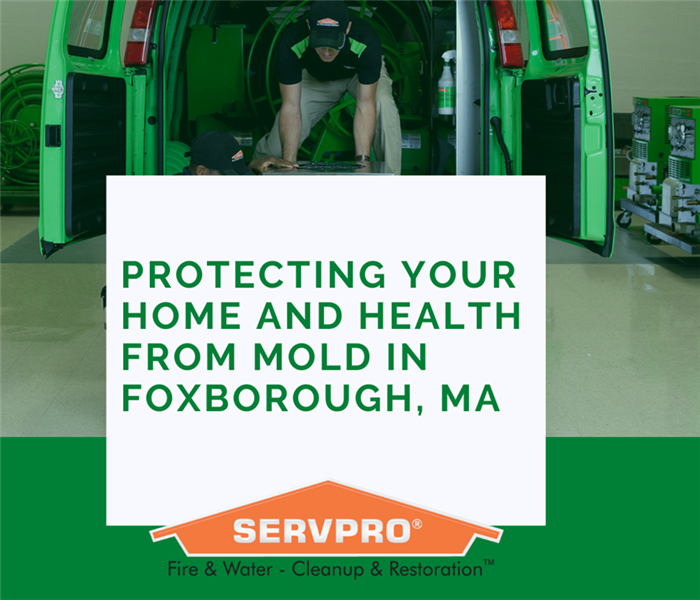 Don't let mold jeopardize the safety and health of your home after water damage.
Don't let mold jeopardize the safety and health of your home after water damage.
Water damage can have far-reaching consequences in your home, and one of the most concerning issues is the growth of mold.
Mold thrives in damp, humid environments, making it a common problem following flood or leak incidents. Exposure to mold can trigger allergic reactions, respiratory problems, and even severe health complications for those with weakened immune systems. Proper mold remediation and prevention measures are crucial for maintaining a safe and healthy living environment.
Identifying Mold Growth: Early detection of mold growth is key to effective remediation. Be on the lookout for musty odors and visible growth on walls, ceilings, or other surfaces. However, mold can also lurk in hidden areas such as behind walls or under flooring, making a thorough professional inspection essential.
Safe Mold Removal: Attempting to remove mold yourself can be risky, as disturbing growth can cause spores to spread through the air, exacerbating the problem. Mold remediation requires specialized equipment and containment techniques to ensure safe removal. Trained professionals employ proven methods to restore your home while protecting you and your family from potential health hazards.
Preventing Future Issues: Once mold has been removed, it's imperative to take steps to prevent future growth. Address any leaks or moisture sources, thoroughly dry out wet areas, and maintain indoor humidity levels below 60%. Use dehumidifiers, ensure proper ventilation in bathrooms and kitchens, and promptly address any new moisture issues to discourage mold growth.
Don't let mold jeopardize the safety and health of your home after water damage. Seek professional mold remediation services to safely and effectively remove mold from your property. Comprehensive water damage restoration is also crucial to ensure your property is dried out completely and prevent recurring mold issues in the future.
Service Areas
Franklin, MA, Millis, MA, Wrentham, MA, Foxborough, MA, Wethersfield, MA, Bellingham, MA, Norfolk, MA
Protecting Your Home and Health From Mold in Norwood / West Roxbury MA
4/12/2024 (Permalink)
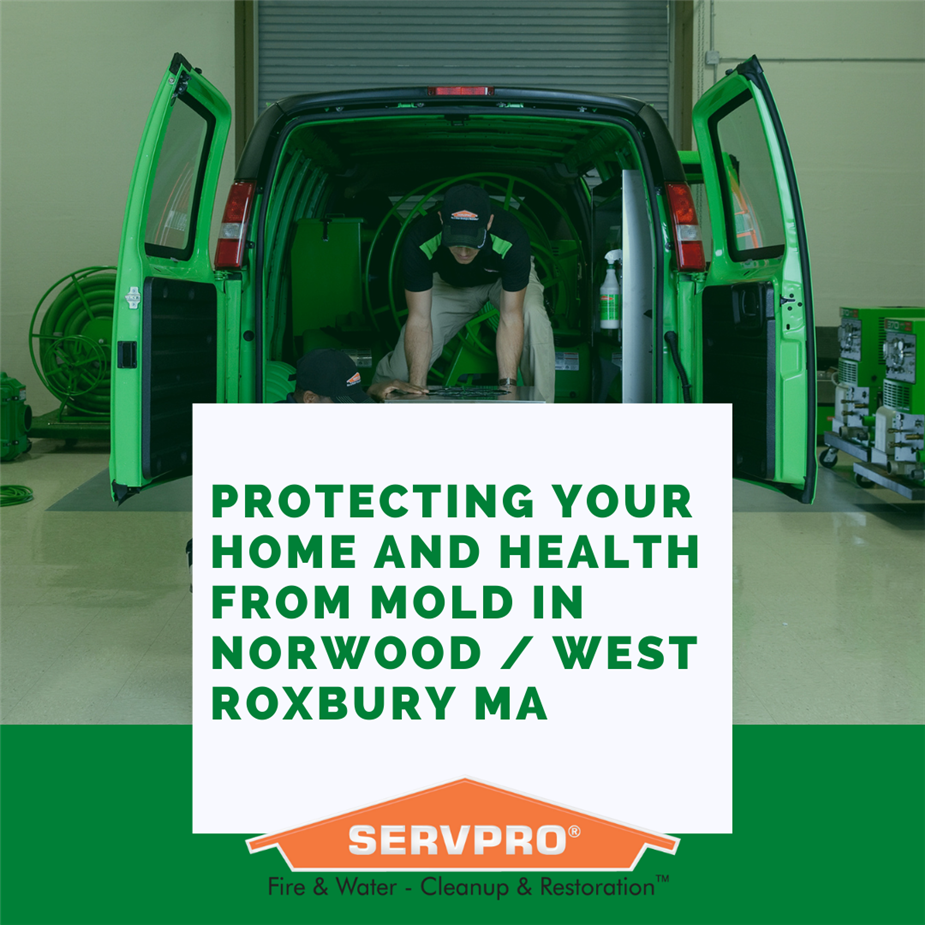 Water damage can lead to a host of issues in your home, but one of the most concerning is mold growth.
Water damage can lead to a host of issues in your home, but one of the most concerning is mold growth.
Water damage can lead to a host of issues in your home, but one of the most concerning is mold growth.
Mold thrives in damp, humid environments, making it a common problem following flood or leak incidents. Exposure to mold can cause allergic reactions, respiratory problems, and even severe health complications for those with weakened immune systems. Proper mold remediation and prevention are crucial for maintaining a safe, healthy living space.
Identifying Mold Growth
Catching mold early is key to effective remediation. Look out for musty odors and visible growth on walls, ceilings, or other surfaces. However, mold can also lurk in hidden areas like behind walls or under flooring, so a thorough professional inspection is necessary.
Safe Mold Removal
Never attempt to remove mold yourself, as disturbing growth can cause spores to spread through the air. Mold remediation requires specialized equipment and containment techniques to remove it safely. Trained professionals use proven methods to ensure your home is restored while protecting you and your family.
Preventing Future Issues
Once mold is removed, it's essential to prevent future growth. Repair any leaks or moisture sources, dry out wet areas completely, and maintain low indoor humidity below 60%. Use dehumidifiers, ensure proper ventilation in bathrooms/kitchens, and promptly address any new moisture issues.
Don't let mold jeopardize your home and health after water damage. Seek professional mold remediation services to safely and effectively remove mold from your property. Comprehensive water damage restoration is also crucial to get your property dried out and prevent recurring mold issues.
Service Areas
Westwood, MA | Dedham, MA | West Roxbury, MA | Norwood, MA | East Dedham, MA | Norwood Centre, MA | Endicott, MA | Walpole, MA
Is Mold a Winter Worry? Exploring Cold-Weather Mold Concerns In Norwood West Roxbury, MA.
1/29/2024 (Permalink)
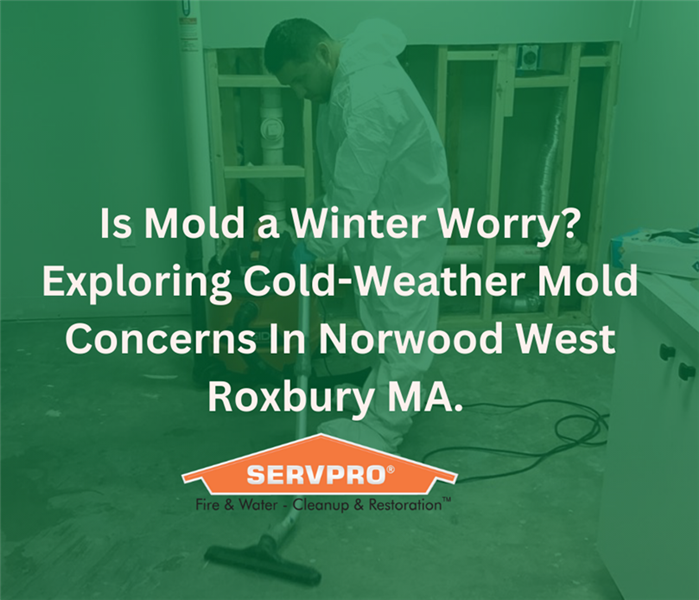 Although mold concerns may not be as conspicuous in winter as during warmer seasons, the cold weather brings its own challenges conducive to mold grow
Although mold concerns may not be as conspicuous in winter as during warmer seasons, the cold weather brings its own challenges conducive to mold grow
When contemplating mold growth, the common association is with damp and warm conditions, often attributed to the summer season.
Nevertheless, mold-related issues are not confined to warmer months, as winter introduces its own set of circumstances that foster mold growth in unexpected areas. Explore the relevance of mold as a concern during winter and delve into the specific cold-weather challenges that homeowners and businesses in Norwood West Roxbury should be mindful of.
Condensation and Indoor Humidity:
- Cold-Weather Concern: In winter, temperature differentials between outdoor and indoor environments can result in condensation on surfaces like windows and walls. This moisture, coupled with indoor humidity, establishes an environment conducive to mold growth.
- Preventive Measures: Maintain indoor humidity levels below 60%, employ exhaust fans in moisture-prone areas like bathrooms and kitchens, and ensure proper ventilation to minimize window condensation.
Ice Dams and Roof Leaks:
- Cold-Weather Concern: Ice dams, formed by snow melting and refreezing on roofs, can lead to water infiltration and roof leaks. If not promptly addressed, this moisture creates favorable conditions for mold growth in attics and ceilings.
- Preventive Measures: Properly insulate and ventilate attics to prevent ice dams. Regularly inspect roofs for leaks and promptly address any issues to prevent water damage.
Mold in Heating Systems:
- Cold-Weather Concern: Mold can thrive in heating systems, particularly in ductwork and on heating coils. As warm air circulates through the system, mold spores can be disseminated throughout the building.
- Preventive Measures: Conduct regular inspections and cleanings of HVAC systems, including ductwork and coils. Use high-quality air filters and consider professional HVAC maintenance.
Basement Moisture Issues:
- Cold-Weather Concern: Cold temperatures may cause condensation on basement walls and floors, while melting snow and frozen ground can contribute to moisture entering basements.
- Preventive Measures: Seal cracks in basement walls, ensure proper drainage away from the foundation, and utilize dehumidifiers to control indoor humidity levels.
Firewood Storage:
- Cold-Weather Concern: Storing firewood indoors for winter heating can introduce moisture into the home, providing a suitable environment for mold growth.
- Preventive Measures: Store firewood outdoors in a dry, covered area, bringing in only small amounts at a time. Keep firewood away from walls and above ground level.
Although mold concerns may not be as conspicuous in winter as during warmer seasons, the cold weather brings its own challenges conducive to mold growth. By comprehending these cold-weather mold concerns and implementing preventive measures such as regular maintenance, proper ventilation, and moisture control, homeowners and businesses can foster a healthy and mold-free indoor environment throughout the winter months in Norwood West Roxbury.
Understanding Water and Mold Damage from Winter Pipe Breaks in Norwood West Roxbury.
12/7/2023 (Permalink)
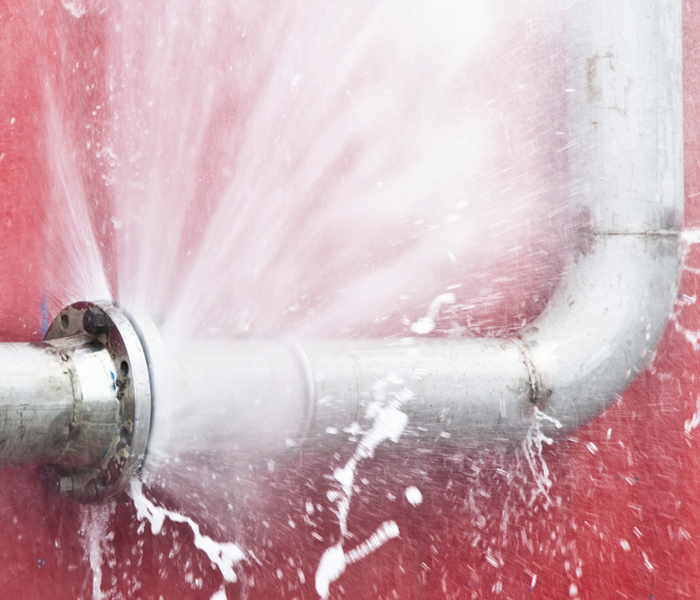 Winter pipe breaks and the ensuing water and mold damage can be a homeowner's nightmare.
Winter pipe breaks and the ensuing water and mold damage can be a homeowner's nightmare.
As winter envelops the world in a tranquil blanket of snow, it ushers in the potential for a less picturesque yet all too common problem: frozen pipes.
The plummeting temperatures can wreak havoc on plumbing systems, resulting in pipe breaks that lead to water damage and, subsequently, the growth of mold. Discover the causes of winter pipe breaks, the repercussions of water damage, and effective measures to prevent and address the aftermath in Norwood West Roxbury.
Understanding Winter Pipe Breaks:
- Frigid Temperatures: The primary culprit behind winter pipe breaks is the freezing of water within the pipes. As water freezes, it expands, exerting substantial pressure on the pipe walls. This heightened pressure can result in cracks, bursts, or complete ruptures in the plumbing system.
- Inadequate Insulation: Insufficient insulation around pipes elevates the risk of freezing, with exposed pipes in attics, basements, or crawl spaces being particularly vulnerable. Proper insulation ensures a consistent temperature, shielding pipes from the harsh winter cold.
Consequences of Winter Pipe Breaks:
- Water Damage: A ruptured pipe can unleash a significant volume of water into your home or business, causing extensive damage to walls, floors, and personal belongings. Swift intervention is essential to prevent further harm and minimize repair costs.
- Mold Growth: The introduction of water significantly raises the likelihood of mold growth. Thriving in damp, humid environments, mold finds an ideal breeding ground in the aftermath of a pipe break.
Preventing and Addressing Water Damage:
- Insulate Pipes: Ensure proper insulation for all pipes, especially those in vulnerable areas, to maintain a consistent temperature and reduce the risk of freezing.
- Maintain Interior Warmth: Sustain a warm environment within your home or business, especially in areas with exposed pipes, through effective heating and insulation.
- Faucet Dripping: On exceptionally cold nights, let faucets drip slowly to keep water flowing, diminishing the chances of pipes freezing.
- Leak Sealing: Regularly inspect and seal any leaks in your home's structure, as even minor leaks can escalate into significant issues in freezing temperatures.
- Emergency Preparedness: Establish an emergency plan, familiarizing yourself with the main water shut-off valve's location and how to quickly turn it off. This proactive step can minimize damage in the event of a pipe break.
Winter pipe breaks and the ensuing water and mold damage can be a homeowner's nightmare. However, with vigilant precautions and a proactive maintenance approach, you can substantially reduce the risk of such incidents. Prevention remains paramount, but in the unfortunate event of a pipe break, swift action is vital to mitigate the damage and shield your home from the harsh consequences of winter's icy grasp.
SERVPRO Of Norwood West Roxbury is The #1 Choice in Cleanup and Restoration for residential and commercial buildings’ water damage.
Sump Pump Failure and the Importance of Preparedness
11/11/2023 (Permalink)
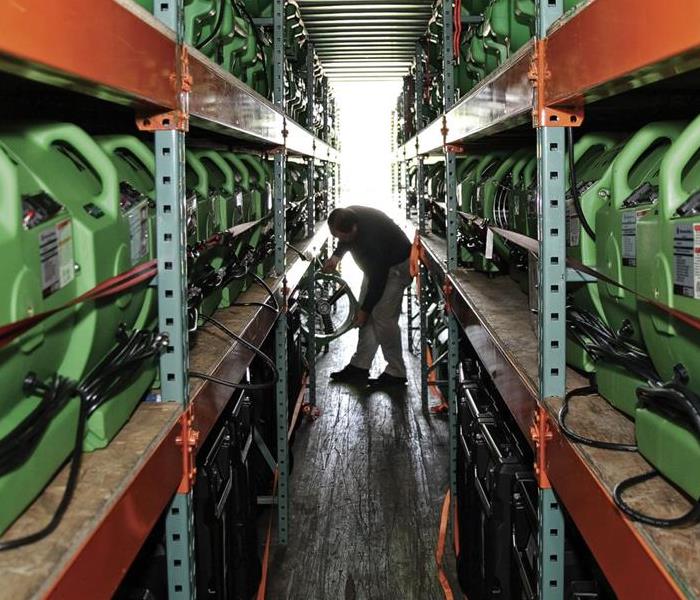 Sump pump failure, often underestimated, poses a significant threat to the safety and integrity of your home.
Sump pump failure, often underestimated, poses a significant threat to the safety and integrity of your home.
In the realm of safeguarding homes from potential water damage, there exists an unsung hero typically concealed in basements and crawl spaces—the sump pump. While quietly performing its duty, diligently preventing basement flooding, its malfunction can result in catastrophic consequences. This overview delves into the causes behind sump pump failure, the indicators to be attentive to, and essential steps to guarantee your home's ongoing protection.
The Unseen Protector: The unassuming sump pump plays a crucial role in averting basement flooding. Nestled in a specially constructed pit, it senses rising water levels and expels excess water from your home's foundation. This uncomplicated yet efficient system serves as a homeowner's initial defense against water damage triggered by heavy rainfall, snowmelt, or ascending groundwater.
Common Causes of Sump Pump Failure:
- Power Outages: In the absence of electricity, the pump remains inoperative, leaving your basement susceptible to flooding.
- Lack of Maintenance: Similar to any mechanical system, regular upkeep is imperative for sump pumps. Over time, debris and sediment accumulation can compromise the pump's efficiency.
- Float Switch Issues: Responsible for activating the pump during rising water levels, mechanical failures or obstructions can impede the float switch's proper functioning, resulting in pump failure.
- Frozen Discharge Pipe: In colder climates, a frozen discharge pipe can hinder the pump's expulsion of water, leading to water backflow into the basement.
- Pump Overwhelm: During intense rainfall or rapid snowmelt, the sump pump may struggle with the volume of water, exerting excessive effort and potentially failing.
Recognizing the Signs:
To preclude being caught off guard by a sump pump failure, it's vital to remain vigilant for warning signs and unusual noises. Grinding or clanking sounds may indicate mechanical issues within the pump.
- Visible Rust or Corrosion: Rust or corrosion on the pump or its components may signal wear and tear, potentially resulting in failure.
- Frequent Cycling: Unusual on-off cycling may indicate problems with the float switch or other components.
- Foul Odors: Unpleasant smells may suggest stagnant water in the sump pit, a consequence of the pump not effectively removing water.
- Schedule regular maintenance to clear debris, test the float switch, and ensure all components are functioning correctly. Additionally, install a battery backup system to maintain sump pump functionality during power outages.
Sump pump failure, often underestimated, poses a significant threat to the safety and integrity of your home. By comprehending common causes, recognizing warning signs, and taking proactive measures, you can minimize the risk of basement flooding and shield your property from the potential ramifications of sump pump failure.
SERVPRO Of Norwood West Roxbury is The #1 Choice in Cleanup and Restoration for residential and commercial buildings’ fire, mold, water, and storm damage. Call us today at (781) 769-9125
Mold FAQ: Your Comprehensive Guide to Understanding Mold
10/24/2023 (Permalink)
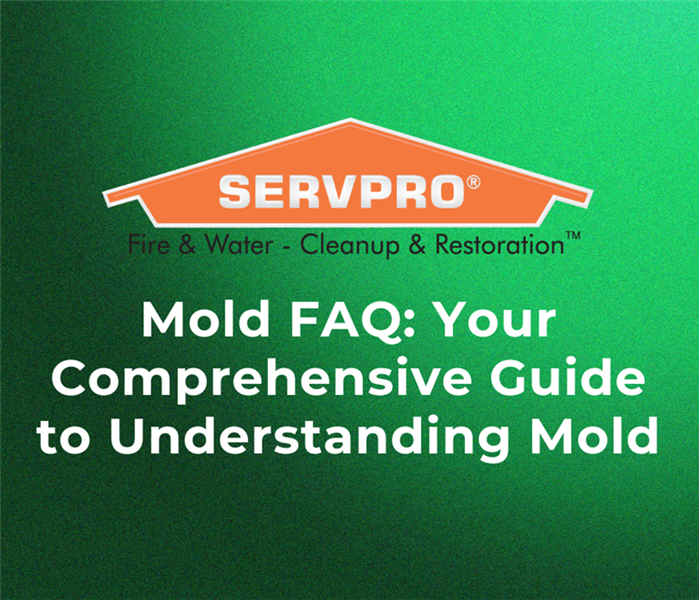 You can effectively manage and mitigate mold problems in your home in Walpole, MA.
You can effectively manage and mitigate mold problems in your home in Walpole, MA.
Mold is a common household problem that can lead to various health issues and property damage in Norwood West Roxbury MA. Many people have questions about mold. Here are answers to some frequently asked questions (FAQ) about mold to help you better understand this issue and how to deal with it effectively.
What is Mold?
Mold is a type of fungus that grows in the form of multicellular filaments called hyphae. It thrives in damp, humid conditions and can appear in various colors and textures. While some molds are harmless, others can produce mycotoxins, which can be harmful to human health.
What Causes Mold Growth?
Mold requires moisture, warmth, and organic material to grow. Common causes of mold growth in homes include water leaks, high humidity, poor ventilation, and damp building materials. Areas like bathrooms, basements, and kitchens are particularly susceptible to mold infestations.
Is Mold Dangerous to Health?
Yes, mold can be harmful to health, especially if it produces mycotoxins. Exposure to mold spores and mycotoxins can lead to a range of health issues, including allergies, respiratory problems, skin irritation, and more severe conditions in individuals with compromised immune systems. It's essential to address mold problems promptly to protect your health.
How Can I Prevent Mold Growth?
To prevent mold growth, you can take several proactive steps:
- Control indoor humidity levels (ideally between 30-50%).
- Fix any leaks or water damage promptly.
- Ensure proper ventilation in high-moisture areas.
- Use exhaust fans in bathrooms and kitchens.
- Clean and dry wet or damp materials and surfaces promptly.
- How Do I Identify Mold in My Home?
Mold is often visually identifiable by its fuzzy or slimy appearance and can come in various colors like black, green, white, or brown. You may also notice a musty odor in mold-infested areas. If you suspect mold, it's a good idea to consult a professional for a thorough inspection in Walpole, MA.
Can I Remove Mold Myself?
For small, surface-level mold problems (less than 10 square feet), you can attempt to clean it yourself using appropriate protective gear, such as gloves, a mask, and eye protection. Use a mixture of soap and water or a specialized mold cleaner. However, for extensive mold infestations, it's best to consult a professional mold remediation service.
How Can I Prevent Mold Recurrence?
To prevent mold from returning, continue to maintain a dry, well-ventilated environment in your home. Regularly inspect for leaks and address any moisture issues promptly. Consider using dehumidifiers in damp areas and ensuring your HVAC system is clean and well-maintained.
Do Home Insurance Policies Cover Mold Damage?
Home insurance policies may cover mold damage, but the coverage can vary widely. It typically depends on the cause of the mold and the specific terms of your policy. To ensure you're adequately covered, review your policy and consult with your insurance provider if necessary.
Understanding mold and how to deal with it is essential for maintaining a healthy and safe living environment. By following preventive measures, promptly addressing moisture issues, and seeking professional help when needed, you can effectively manage and mitigate mold problems in your home in Walpole, MA. If you have concerns about mold in your living space, it's always wise to consult with experts who can provide guidance and remediation services to keep your home mold-free and safe for your family's well-being.
SERVPRO® Of Norwood West Roxbury is The #1 Choice in Cleanup and Restoration for residential and commercial buildings’ fire, mold, water, and storm damage. Call us today at (781) 769-9125
Dealing with Mold: Your Comprehensive Guide to Mold Remediation
9/6/2023 (Permalink)
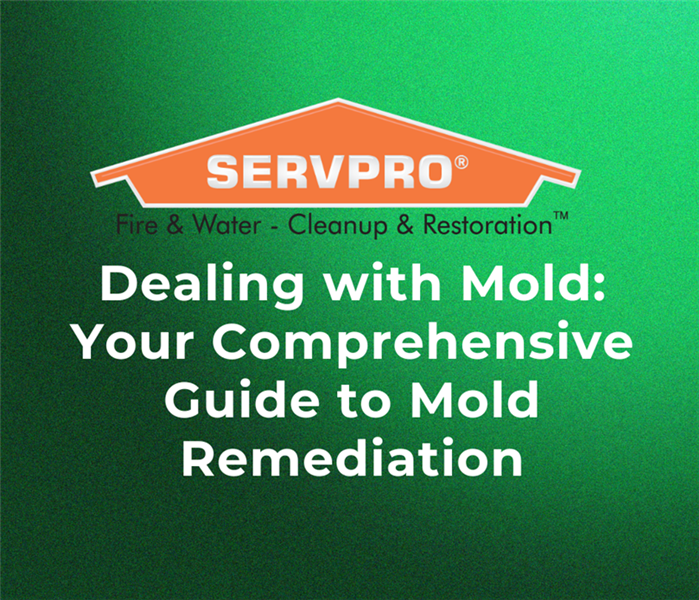 Here is what to do if you discover mold in your home and how to effectively tackle this issue.
Here is what to do if you discover mold in your home and how to effectively tackle this issue.
Mold thrives in damp, dark, and humid environments, making basements, bathrooms, and kitchens susceptible areas. Here is what to do if you discover mold in your home and how to effectively tackle this issue.
- Identify the Mold: Before you can effectively deal with mold, you need to identify the type and extent of the infestation. There are various types of mold, with some being more harmful than others. Common indoor molds include black mold (Stachybotrys chartarum), green mold (Aspergillus), and white mold (Penicillium). If you are unsure about the type of mold you are dealing with, consider hiring a professional mold inspector who can provide an accurate assessment.
- Safety First: When dealing with mold, safety should be your top priority. Mold can release harmful spores and mycotoxins into the air, which can be dangerous when inhaled. To protect yourself, follow these safety precautions:
- Wear protective gear, including an N95 respirator, gloves, and eye protection.
- Isolate the contaminated area to prevent mold spores from spreading to other parts of your home.
- Ensure proper ventilation by opening windows and doors to allow fresh air to circulate.
- Remove Moisture Sources: Mold thrives in moist environments, so the first step in mold remediation is to identify and eliminate the source of moisture. Fix any leaks, repair roof damage, and improve ventilation in damp areas like basements and bathrooms. A dehumidifier can also help reduce humidity levels in your home.
- Cleaning and Mold Removal: The method of mold removal depends on the extent of the infestation and the affected materials. Here are some general steps to follow:
- For small surface mold growth, clean the affected area with a mixture of soap and water or a commercial mold cleaner.
- For larger infestations, you may need to remove and replace contaminated materials, such as drywall, insulation, or carpet. Be cautious not to disturb the mold, as this can release more spores into the air.
- Consider Professional Help: If the mold problem is extensive, toxic mold is suspected, or you have health concerns, it's advisable to hire a professional mold remediation service. These experts have the necessary equipment and expertise to safely and effectively remove mold from your home.
After you have successfully removed the mold, take steps to prevent it from returning:
- Maintain proper ventilation and humidity levels in your home.
- Regularly inspect and repair any leaks or water damage.
- Clean and dry damp areas promptly.
- Use mold-resistant materials in areas prone to moisture.
Dealing with mold can be a daunting task, but with the right knowledge and precautions, you can effectively address the issue and protect your home and health. Remember that safety should always come first, and when in doubt, seek professional assistance. By identifying and addressing the source of the problem and following proper remediation procedures, you can create a healthier living environment for you and your family.
SERVPRO Of Norwood West Roxbury is The #1 Choice in Cleanup and Restoration for residential and commercial buildings’ fire, mold, water, and storm damage. If you are looking for assistance, just click on the contact us page, and someone will be in touch shortly.
Can Mold Cause A Smell To The House?
5/23/2023 (Permalink)
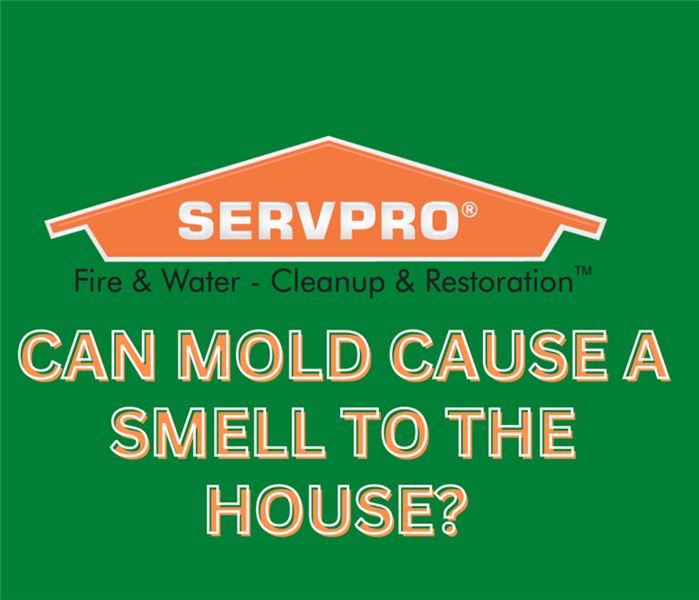 If you discover mold in your home, it's important to take action to remove it as soon as possible.
If you discover mold in your home, it's important to take action to remove it as soon as possible.
Not only can mold cause damage to your home and pose health risks, but it can also create a foul smell that can be difficult to get rid of. Here is what you can do to prevent mold.
What Causes the Smell?
Mold releases a musty odor that can be quite unpleasant. This smell is caused by the chemicals released by mold as it grows and breaks down organic matter. Mold thrives in damp environments, such as bathrooms, basements, and areas with water damage. If you notice a musty odor in your home, it could be a sign that mold is present.
Health Risks Associated with Mold.
Mold not only creates a foul smell but can also pose health risks to you and your family. Exposure to mold can cause allergic reactions, respiratory problems, and other health issues. Children, the elderly, and people with weakened immune systems are particularly vulnerable to mold-related health problems. If you suspect that mold is present in your home, it's important to take action to address the issue as soon as possible.
Here are some steps you can take to prevent mold growth in your home:
- Reduce humidity levels: Mold thrives in humid environments, so it's important to keep humidity levels low. Use dehumidifiers in areas prone to moisture, such as basements and bathrooms.
- Fix leaks: Mold needs moisture to grow, so fixing any leaks in your home is crucial. Check for leaks around windows, doors, and pipes, and repair them promptly.
- Use ventilation: Proper ventilation can help prevent mold growth. Use exhaust fans in bathrooms and kitchens, and open windows to increase airflow.
- Clean regularly: Regular cleaning can help prevent mold growth. Clean surfaces regularly with a solution of bleach and water, and use mold-resistant paint in areas prone to moisture.
If you discover mold in your home, it's important to take action to remove it as soon as possible. Here are some steps you can take to remove mold:
- Identify the source: Identify the source of the moisture that's causing the mold to grow. Fix any leaks or water damage before removing the mold.
- Use protective equipment: Wear protective equipment, such as gloves and a mask, to avoid inhaling mold spores.
- Clean surfaces: Clean surfaces with a solution of bleach and water. Use a scrub brush to remove the mold from porous surfaces, such as drywall.
- Dry the area: After cleaning the mold, dry the area thoroughly to prevent the mold from returning.
Prevention is key when it comes to dealing with mold. Reduce humidity levels, fix leaks, use ventilation, and clean regularly to prevent mold growth. If you discover mold in your home, take action to remove it promptly.
SERVPRO Of Norwood West Roxbury is The #1 Choice in Cleanup and Restoration for residential and commercial buildings’ fire, mold, water, and storm damage.
We service Blackstone, Hopedale, Mendon, Milford, Natick, North Natick, and South Natick MA.
What to do if there is mold in your walls
4/7/2023 (Permalink)
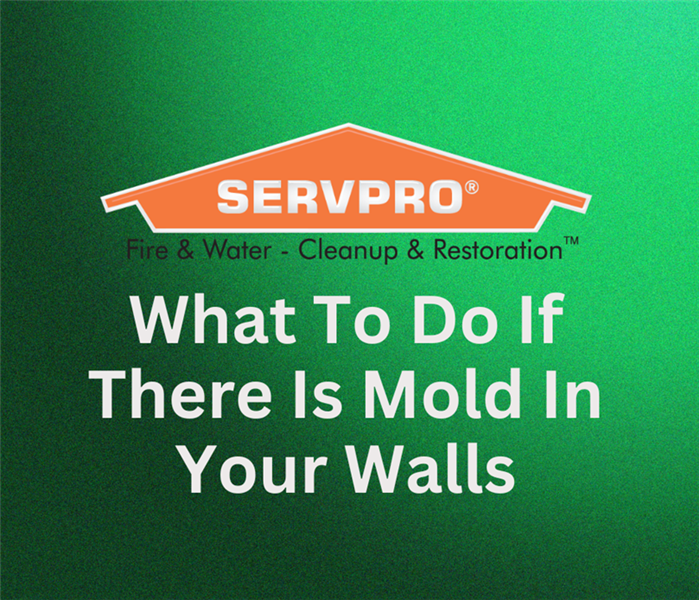 Dealing with mold on your walls can be a daunting task, but it's important to take action as soon as possible to prevent it from spreading.
Dealing with mold on your walls can be a daunting task, but it's important to take action as soon as possible to prevent it from spreading.
Mold can also be a health hazard if left untreated. If you have mold on your walls, it's important to take action as soon as possible to prevent it from spreading.
- Identify the cause of the mold: The first step in dealing with mold on your walls is to identify the underlying cause. Mold thrives in damp, humid environments, so it's important to identify any sources of moisture that may be contributing to the problem. Common causes of mold on walls include leaky pipes, roof leaks, high humidity levels, and poor ventilation.
- Remove the mold: Once you have identified the cause of the mold, it's time to remove it from your walls. Depending on the severity of the mold, you may be able to clean it yourself using a mixture of water and bleach or vinegar. However, if the mold has spread over a large area or is particularly stubborn, it's best to call in a professional mold remediation company to ensure that it is completely removed.
- Repair any damage: Once the mold has been removed, it's important to repair any damage to your walls. This may include replacing any damaged drywall or insulation, repairing leaks, or installing a dehumidifier to help control moisture levels.
- Prevent future mold growth: To prevent mold from growing on your walls in the future, it's important to take steps to control moisture levels in your home. This may include repairing any leaks promptly, using a dehumidifier in areas with high humidity, and ensuring that your home is properly ventilated.
Dealing with mold on your walls can be a daunting task, but it's important to take action as soon as possible to prevent it from spreading.
We service Dedham, East Dedham, Endicott, Medfield, Norwood Centre, Norwood, Walpole, MA, and Westwood, MA
SERVPRO Of Norwood West Roxbury is The #1 Choice in Cleanup and Restoration for residential and commercial buildings’ fire, mold, water, and storm damage.
How to prevent mold damage in Norwood West Roxbury MA
3/5/2023 (Permalink)
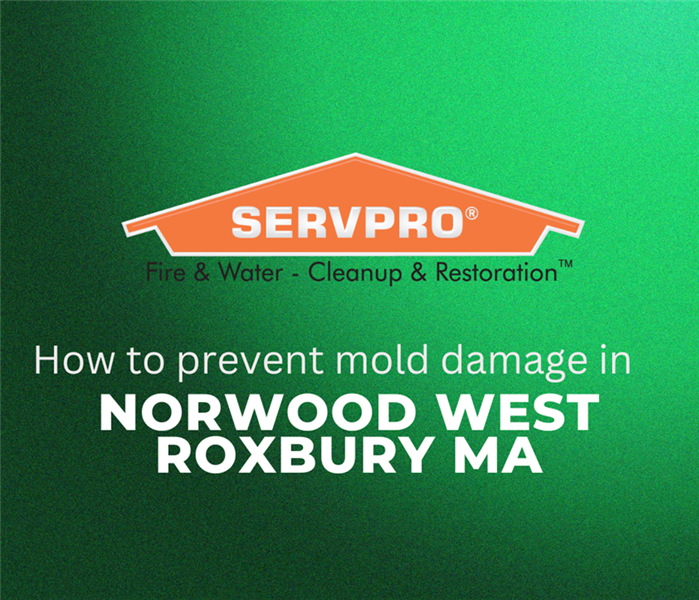 SERVPRO Of Norwood West Roxbury is The #1 Choice in Cleanup and Restoration for residential and commercial buildings’ fire, mold, water, and storm
SERVPRO Of Norwood West Roxbury is The #1 Choice in Cleanup and Restoration for residential and commercial buildings’ fire, mold, water, and storm
Mold is a common problem that affects many households. It can cause significant damage to your property and even pose a health risk to you and your family. Mold grows in damp and humid environments, and it can thrive on various surfaces, including walls, ceilings, carpets, and furniture. Fortunately, there are ways to prevent mold damage in your home.
- Keep your home dry: Mold thrives in damp and humid environments, so the best way to prevent mold damage is to keep your home dry. You can do this by fixing any leaks in your plumbing, roof, or windows. Make sure that your home is properly ventilated, especially in areas like the bathroom, kitchen, and laundry room.
- Clean and maintain your HVAC system: Your HVAC system plays a crucial role in maintaining the air quality in your home. It can also help to prevent mold growth. Make sure to clean and maintain your HVAC system regularly to prevent any buildup of dust or moisture, which can lead to mold growth.
- Use mold-resistant products: When renovating or building your home, consider using mold-resistant materials such as drywall, paints, and insulation. These materials are specially designed to resist mold growth.
- Monitor indoor humidity levels: Mold thrives in humid environments, so it's important to keep an eye on indoor humidity levels. The ideal humidity level is between 30 and 50 percent. You can use a hygrometer to measure the humidity levels in your home.
- Clean and dry any water damage promptly: Water damage is one of the leading causes of mold growth. If you experience any water damage in your home, it's important to clean and dry the affected area as soon as possible.
Mold damage can be a significant problem for homeowners, but it's a problem that can be prevented. By keeping your home dry, maintaining your HVAC system, using mold-resistant products, monitoring indoor humidity levels, and cleaning and drying any water damage promptly, you can help to prevent mold growth and protect your home from mold damage.
We service Dedham, East Dedham, Endicott, Medfield, Norwood Centre, Norwood, Walpole, MA, and Westwood, MA
SERVPRO Of Norwood West Roxbury is The #1 Choice in Cleanup and Restoration for residential and commercial buildings’ fire, mold, water, and storm damage.
How Does Mold Damage Happen?
2/15/2023 (Permalink)
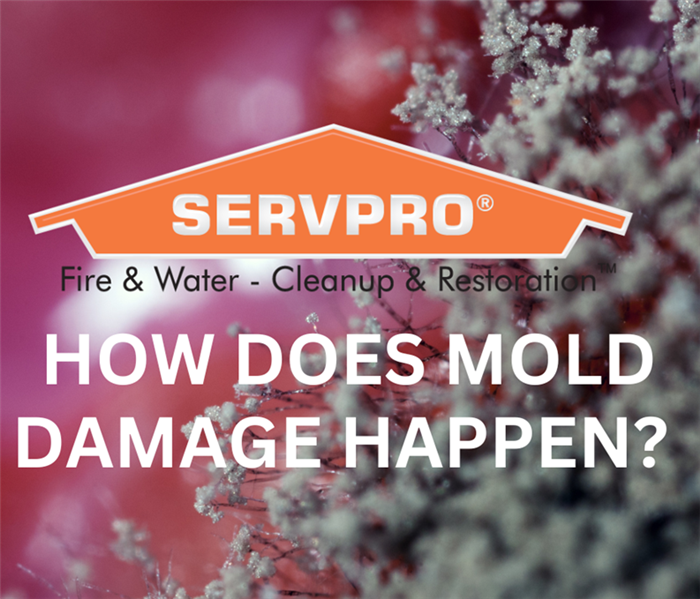 If you suspect that you have mold damage in your building, it is important to address the problem as soon as possible.
If you suspect that you have mold damage in your building, it is important to address the problem as soon as possible.
Mold is a type of fungus that thrives in damp and humid environments. It grows quickly and can spread rapidly, causing damage to the structure of a building and posing a health risk to its occupants.
Causes of Mold Damage
Mold thrives in damp and humid conditions. This means that any area of a building that is exposed to moisture is at risk of developing mold. Some of the most common causes of mold damage include:
- Water leaks: Leaky pipes, roofs, and windows can all contribute to the growth of mold.
- Flooding: If a building is flooded, the excess water can create a perfect breeding ground for mold.
- Humidity: High levels of humidity in a building can create conditions that are ideal for mold growth.
- Poor ventilation: Without adequate ventilation, moisture can become trapped in a building, providing a perfect environment for mold to grow.
Effects of Mold Damage
Mold damage can have a number of negative effects on a building and its occupants. Some of the most common effects include:
- Structural damage: Mold can weaken the structure of a building, leading to cracks, warping, and other forms of damage.
- Health risks: Exposure to mold can lead to a number of health problems, including respiratory issues, allergic reactions, and skin irritation.
- Property damage: Mold can damage walls, floors, and other surfaces, requiring expensive repairs and replacements.
Prevention of Mold Damage
Preventing mold damage is much easier than dealing with it after it has already occurred. Here are some tips for preventing mold growth in your building:
- Keep humidity levels under control: Make sure that your building has adequate ventilation and use dehumidifiers to control humidity levels.
- Repair water leaks: Fix any leaks as soon as they are detected to prevent moisture from building up.
- Keep your building clean: Regular cleaning can help prevent mold growth by removing any spores that may be present.
- Inspect your building regularly: Regular inspections can help you identify any potential problems before they become major issues.
Remediation of Mold Damage
If you suspect that you have mold damage in your building, it is important to address the problem as soon as possible. Here are the steps involved in mold remediation:
- Identify the source of the problem: Determine the source of the moisture that is causing the mold growth.
- Contain the mold: Use barriers to prevent the mold from spreading to other areas of the building.
- Remove the mold: Use specialized equipment and cleaning agents to remove the mold.
- Repair any damage: Repair any damage that was caused by the mold growth.
- Take steps to prevent future mold growth: Take steps to prevent future mold growth by addressing any moisture problems and keeping the building clean.
Mold damage is a serious problem that can have a number of negative effects on a building and its occupants.
SERVPRO of Norwood West Roxbury is your premier choice for damage and restoration. Our teams are ready to respond 24 hours a week, any day of the year. When you bring us on the job our team of licensed contractors and certified technicians will work collaboratively with you throughout the duration of the project. They will keep you updated on the project's status and ensure that your expectations are met. We will help you to move forward and make it “Like it never even happened” for all of your fire damage.
SERVPRO of Norwood West Roxbury Shares Preventing Mold Damage: Essential Tips for a Healthy Home
2/5/2023 (Permalink)
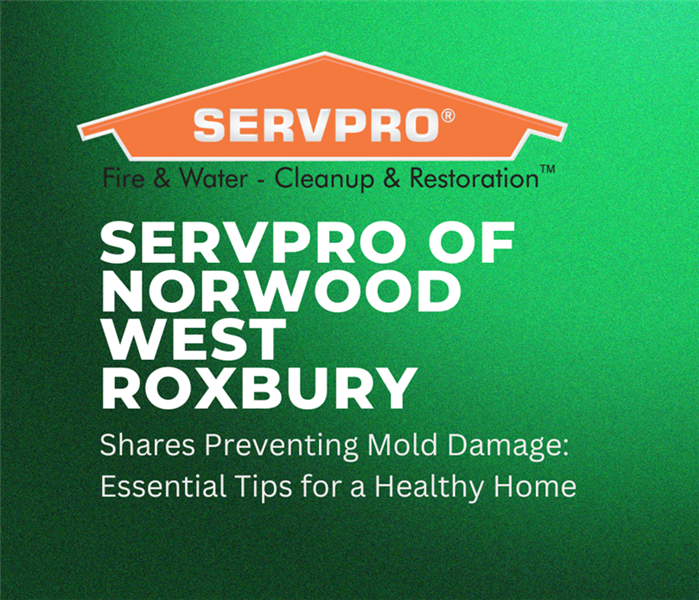 If you suspect mold growth in your home, it is important to have it inspected and professionally remediated to avoid further damage.
If you suspect mold growth in your home, it is important to have it inspected and professionally remediated to avoid further damage.
Mold damage can be a major problem in many homes. Here are some tips to help you prevent mold damage in your home:
- Control humidity levels: Mold thrives in moist environments, so it is essential to keep indoor humidity levels low. Use a dehumidifier to remove excess moisture from the air
- Fix leaks: Promptly fix any leaks in your roof, walls, or plumbing to prevent water damage and mold growth.
- Keep surfaces clean and dry: Regularly clean and dry surfaces in high-risk areas such as bathrooms, kitchens, and basements. Use a mold-resistant cleaning solution to disinfect surfaces and prevent mold from growing.
- Increase ventilation: Ensure that your home has proper ventilation to help prevent mold growth. This can be achieved by opening windows and doors regularly, using exhaust fans, and keeping air vents clear.
- Inspect and maintain HVAC systems: Your heating, ventilation, and air conditioning systems can become a breeding ground for mold if not properly maintained. Inspect them regularly and have them serviced by a professional if needed.
- Store items properly: Store items, especially paper products and organic materials, properly in sealed containers to prevent mold growth.
- Regularly inspect your home: Regular inspections of your home can help identify mold damage early, allowing you to take action before it becomes a bigger problem. Look for discoloration on walls and ceilings, a musty odor, or any other signs of moisture damage.
By following these tips, you can help prevent mold damage in your home and your home's structure. If you suspect mold growth in your home, it is important to have it inspected and professionally remediated to avoid further damage and health problems.
SERVPRO of Norwood West Roxbury is your premier choice for fire damage and restoration. Our teams are ready to respond 24 hours a week, any day of the year. When you bring us on the job our team of licensed contractors and certified technicians will work collaboratively with you throughout the duration of the project. They will keep you updated on the project's status and ensure that your expectations are met. We will help you to move forward and make it “Like it never even happened” for all of your fire damage.
What Is Mold?
6/5/2018 (Permalink)
What is mold? Mold is a fungus that grows in the form of multicellular filaments called hyphae.. This means that, like you and I, mold is a living organism. Mold spores are microscopic in size and, believe it or not, they exist naturally everywhere. Removing all traces of mold from a home or business is impossible. In actuality, mold testing is not done to determine if mold exists, but rather, to determine if elevated levels of mold exists. Proper mold testing consists of comparing indoor air quality to the air quality of the surrounding external environment.
Three conditions must exist for mold to cultivate. The first would be the availability of food. Any organic, carbon based, porous material is the only source of food mold spores require. The second would be having an appropriate temperature. Contrary to popular belief, mold can grow in any temperature above freezing, for example have you ever found moldy food in your refrigerator? The ideal temperature for mold to grow is in between 59° F – 86° F. Lastly having a considerable amount of moisture is a condition necessary that supports mold. It does not take long either; when all three conditions exist mold infestation can begin in less than 48 hours! The good news is that eliminating any one of these three conditions will ensure be mold free environment.
The not-so-good news is unfortunately, ninety percent of building materials used can serve as food for mold. Temperatures in New England during late spring and summer months are perfect for mold growth. Lastly, leaky roofs, improper bathroom ventilation, or poorly installed finished basements are just a few of the many issues that will cause the increased levels of moisture needed to stimulate mold growth. We cannot change the materials used to build our homes or the temperatures outside but we can control moisture. The good news is as humans we actually prefer humidity levels that are well below the critical relative humidity necessary for mold growth. That means, in most situations, the simple purchase of a dehumidifier is all the protection needed to mitigate mold growth.
But, what happens when disaster strikes and a simple dehumidifier is not enough? Up next – Why Call SERVPRO.
SERVPRO Mold Remediation
6/5/2018 (Permalink)
When approaching mold clean up a lot of people wonder which method is best, “Dry Blast” vs “Sand Blast”, The answer is neither , the reality in today’s world is this is unnecessary because; dry ice is costly, it only removes surface mold, and porous materials require a deep cleaning. SERVPRO technicians use anti-fungal and anti-microbial treatments that kill mold colonies and help prevent new colonies from forming
When tackling mold we make it a priority to set up containment. All remediation companies will set up containment, but when and how is the issue. We set up containment prior to applying the “eyeball test”. Which is as follows
- The “Eyeball Test” – Assessing the Environment
- Has there been a previous water damage
- Do you smell musty odors of mold
- Do you see areas of mold contamination
- Our competitors cut 4 x 8 holes in the wall from the ground up
- We cut a 2 x 4 in the center of the wall
Got Mold?
6/5/2018 (Permalink)
Do you think that you may have mold in your home or place of business? While mold spores exist naturally everywhere high levels in contained spaces can cause serious health issues. Mold spores are airborne particles which can be eliminated by creating a negative air chamber. One piece of equipment that we often use is the DefenderAir HEPA 500 is ideal for handling indoor air-quality needs on every restoration job. This unit address these air-quality issues quickly and effectively, helping you to maintain a clean indoor environment. The DefendAir has an efficiency rating of 99.97% against 0.3-micron oily aerosol particles and meets first-pass filtration requirements for even the most sensitive jobs. If you think that you may have an infestation of mold give our Disaster Recovery Team a call today!
Recognizing Mold
6/5/2018 (Permalink)
How to Recognize Mold:
- Sight – They usually appear as distinctly colored woolly mats (e.g., mildew is black and is one of the most common molds in a household).
- Smell – They often produce a foul odor, such as a musty, earthy smell.
The key to mold prevention is moisture control. Mold will not grow if moisture is absent.
- Remove excess standing moisture with a wet-dry vacuum and remove the any excess humidity with a dehumidifier
- Use fans to assist in the drying process.
- Clean wet materials and surfaces with detergent and water.
- Discard all water damaged materials and all materials visibly contaminated with mold.
- Remove and discard all porous materials that have been wet for more than 48 hours such as:
- Carpeting and carpet padding
- Upholstery, wallpaper, drywall
- Floor and ceiling tiles, insulation materials
- Clothing
Do You Have Mold?
5/10/2017 (Permalink)
Do you think that you may have mold in your home or place of business? While mold spores exist naturally everywhere high levels in contained spaces can cause serious health issues. Mold spores are airborne particles which can be eliminated by creating a negative air chamber. One piece of equipment that we often use is the DefenderAir HEPA 500 is ideal for handling indoor air-quality needs on every restoration job. This unit address these air-quality issues quickly and effectively, helping you to maintain a clean indoor environment. The DefendAir has an efficiency rating of 99.97% against 0.3-micron oily aerosol particles and meets first-pass filtration requirements for even the most sensitive jobs. If you think that you may have an infestation of mold give our Disaster Recovery Team a call today!
What Are the Potential Health Effects of Mold
5/10/2017 (Permalink)
According the CDC mold exposure does not always present a health problem indoors. However some people are sensitive to molds. These people may experience symptoms such as nasal stuffiness, eye irritation, wheezing, or skin irritation when exposed to molds. Some people may have more severe reactions to molds. Severe reactions may occur among workers exposed to large amounts of molds in occupational settings, such as farmers working around moldy hay. Severe reactions may include fever and shortness of breath. Immunocompromised persons and persons with chronic lung diseases like COPD are at increased risk for opportunistic infections and may develop fungal infections in their lungs.
In 2004 the Institute of Medicine (IOM) found there was sufficient evidence to link indoor exposure to mold with upper respiratory tract symptoms, cough, and wheeze in otherwise healthy people; with asthma symptoms in people with asthma; and with hypersensitivity pneumonitis in individuals susceptible to that immune-mediated condition. The IOM also found limited or suggestive evidence linking indoor mold exposure and respiratory illness in otherwise healthy children.
Mold Removal
4/13/2017 (Permalink)
When approaching mold clean up a lot of people wonder which method is best, “Dry Blast” vs “Sand Blast”, The answer is neither , the reality in today’s world is this is unnecessary because; dry ice is costly, it only removes surface mold, and porous materials require a deep cleaning. SERVPRO technicians use anti-fungal and anti-microbial treatments that kill mold colonies and help prevent new colonies from forming
When tackling mold we make it a priority to set up containment. All remediation companies will set up containment, but when and how is the issue. We set up containment prior to applying the “eyeball test”. Which is as follows
- The “Eyeball Test” – Assessing the Environment
- Has there been a previous water damage
- Do you smell musty odors of mold
- Do you see areas of mold contamination
- Our competitors cut 4 x 8 holes in the wall from the ground up
- We cut a 2 x 4 in the center of the wall
What is Mold?
4/12/2017 (Permalink)
What is mold? Mold is a fungus that grows in the form of multicellular filaments called hyphae.. This means that, like you and I, mold is a living organism. Mold spores are microscopic in size and, believe it or not, they exist naturally everywhere. Removing all traces of mold from a home or business is impossible. In actuality, mold testing is not done to determine if mold exists, but rather, to determine if elevated levels of mold exists. Proper mold testing consists of comparing indoor air quality to the air quality of the surrounding external environment.
Three conditions must exist for mold to cultivate. The first would be the availability of food. Any organic, carbon based, porous material is the only source of food mold spores require. The second would be having an appropriate temperature. Contrary to popular belief, mold can grow in any temperature above freezing, for example have you ever found moldy food in your refrigerator? The ideal temperature for mold to grow is in between 59° F – 86° F. Lastly having a considerable amount of moisture is a condition necessary that supports mold. It does not take long either; when all three conditions exist mold infestation can begin in less than 48 hours! The good news is that eliminating any one of these three conditions will ensure be mold free environment.
The not-so-good news is unfortunately, ninety percent of building materials used can serve as food for mold. Temperatures in New England during late spring and summer months are perfect for mold growth. Lastly, leaky roofs, improper bathroom ventilation, or poorly installed finished basements are just a few of the many issues that will cause the increased levels of moisture needed to stimulate mold growth. We cannot change the materials used to build our homes or the temperatures outside but we can control moisture. The good news is as humans we actually prefer humidity levels that are well below the critical relative humidity necessary for mold growth. That means, in most situations, the simple purchase of a dehumidifier is all the protection needed to mitigate mold growth.
But, what happens when disaster strikes and a simple dehumidifier is not enough? Up next – Why Call SERVPRO.





 24/7 Emergency Service
24/7 Emergency Service














